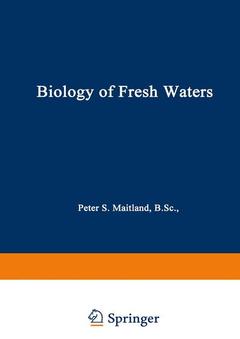Description
Biology of Fresh Waters, Softcover reprint of the original 1st ed. 1990
Tertiary Level Biology Series
Author: Maitland P.S.
Language: EnglishApproximative price 105.49 €
In Print (Delivery period: 15 days).
Add to cart
Publication date: 01-2013
276 p. · 14.8x21 cm · Paperback
276 p. · 14.8x21 cm · Paperback
Description
/li>Contents
/li>
In the decade since the first edition of this book was published advances have been made in our knowledge of the fresh waters of the world, espe cially in understanding many of the processes involved in their functioning as systems and in countering the problems created by human activities. New problems too, many of an international nature, have loomed during this period-of which global warming and the acidification offresh waters in many parts of the world are notable examples. In addition, much has now been published concerning the aquatic flora, fauna and ecology of previously poorly known geographic areas, notably Australasia. The second edition of this book is a revision which updates the text in the light of recent advances in our knowledge of freshwater biology. Inevitably, in an elementary volume such as this, the treatment of many of the basic principles and processes remains the same. However, several new sections are included covering a range of topics such as acid deposition and the acidification process, bacterial decomposition and aquaculture. The book includes many new references and suggestions for up-to-date reading in particular topics. The objective of the second edition remains the same as that of the first. It is intended as a basic introduction to the major aspects of freshwater biology at a level suitable for undergraduates. It should also prove useful, as apparently did the first edition,Jo professional workers in related fields, e.g. water engineers and chemists, aquaculturists and planners.
1 The Aquatic Environment.- 1.1 Physics.- 1.1.1 Radiant energy and optics.- 1.1.2 Density and thermal properties.- 1.1.3 Movement.- 1.1.4 Suspended solids.- 1.2 Chemistry.- 1.2.1 Oxygen.- 1.2.2 Carbon dioxide.- 1.2.3 pH and the hydrogen ion.- 1.2.4 Nitrogen.- 1.2.5 Phosphorus.- 1.2.6 Iron.- 1.2.7 Other dissolved solids.- 1.3 Biology.- 1.3.1 Decomposition.- 1.3.2 Photosynthesis.- 1.3.3 Nutrient limitation.- 1.3.4 Influence of organisms on the environment.- 2 Plants and Animals of Fresh Waters.- 2.1 Viruses.- 2.2 Bacteria.- 2.3 Algae.- 2.3.1 Euglenophytes.- 2.3.2 Cryptophytes.- 2.3.3 Dinophytes.- 2.3.4 Chlorophytes.- 2.3.5 Xanthophytes.- 2.3.6 Chrysophytes.- 2.3.7 Phaeophytes.- 2.3.8 Bacillariophytes.- 2.3.9 Rhodophytes.- 2.3.10 Cyanophytes.- 2.4 Fungi.- 2.5 Lichens.- 2.6 Stoneworts.- 2.7 Bryophytes.- 2.7.1Liverworts.- 2.7.2 Mosses.- 2.8 Pteridophytes.- 2.8.1 Lycopsids.- 2.8.2 Horsetails.- 2.8.3 Ferns.- 2.9 Spermatophytes.- 2.9.1 Dicotyledons.- 2.9.2 Monocotyledons.- 2.10 Protozoans.- 2.10.1 Zoomastigines.- 2.10.2 Rhizopods.- 2.10.3 Actinopods.- 2.10.4 Sporozoans.- 2.10.5 Ciliates.- 2.11 Sponges.- 2.12 Coelenterates.- 2.13 Platyhelminths.- 2.13.1 Flatworms.- 2.13.2 Flukes.- 2.13.3 Tapeworms.- 2.14 Proboscis worms.- 2.15 Aschelminths.- 2.15.1 Rotifers.- 2.15.2 Gastrotrichs.- 2.15.3 Hairworms.- 2.15.4 Roundworms.- 2.16 Acanthocephalans.- 2.17 Entoprocts.- 2.18 Polyzoans.- 2.19 Molluscs.- 2.19.1 Snails.- 2.19.2 Bivalves.- 2.20 Annelid worms.- 2.20.1 Polychaetes.- 2.20.2 Oligochaetes.- 2.20.3 Leeches.- 2.21 Arthropods.- 2.21.1 Insects.- 2.21.2 Crustaceans.- 2.21.3 Arachnids.- 2.21.4 Tardigrades.- 2.22 Chordates.- 2.22.1 Lampreys.- 2.22.2 Sharks and rays.- 2.22.3 Bony fish.- 2.22.4 Lungfish.- 2.22.5 Amphibians.- 2.22.6 Reptiles.- 2.22.7 Birds.- 2.22.8 Mammals.- 3 Standing Waters: Lakes, Ponds and Pools.- 3.1 Origin.- 3.2 Physical characteristics.- 3.2.1 Stratification.- 3.2.2 Water movement.- 3.2.3 Suspended solids.- 3.2.4 Light.- 3.3 Chemical characteristics.- 3.3.1 Dissolved gases—oxygen.- 3.3.2 Dissolved gases—carbon dioxide.- 3.3.3 Dissolved solids.- 3.4 Biological characteristics.- 3.4.1 Habitats.- 3.4.2 Microhabitats.- 3.4.3 Communities.- 3.5 Classification.- 4 Running Waters: Rivers, Streams and Trickles.- 4.1 Physical characteristics.- 4.1.1 Current.- 4.1.2 Suspended solids.- 4.1.3 Light.- 4.1.4 Temperature.- 4.1.5 Run-off.- 4.2 Chemical characteristics.- 4.2.1 Dissolved gases.- 4.2.2 Dissolved solids.- 4.3 Biological characteristics.- 4.3.1 Habitats.- 4.3.2 Microhabitats.- 4.3.3 Communities.- 4.4 Classification.- 5 Field Studies: Sampling in Fresh Waters.- 5.1 Physical.- 5.1.1 Sediments and bathymetry.- 5.1.2 Movement.- 5.1.3 Light.- 5.1.4 Temperature.- 5.2 Chemistry.- 5.3 Biology.- 5.3.1 Decomposition.- 5.3.2 Photosynthesis.- 5.3.3 Attached algae.- 5.3.4 Macrophytes.- 5.3.5 Plankton.- 5.3.6 Benthic invertebrates.- 5.3.7 Fish.- 6 Adaptation to Environment: Strategies for Survival.- 6.1 Major adaptations.- 6.1.1 Shape.- 6.1.2 Osmoregulation.- 6.1.3 Respiration.- 6.1.4 Other physiological features.- 6.1.5 Buoyancy.- 6.1.6 Symbiosis.- 6.1.7 Behaviour.- 6.1.8 Dispersal.- 6.2 Adaptation to specific habitats.- 6.2.1 Running waters.- 6.2.2 Profundal regions.- 6.2.3 Plankton.- 6.2.4 Neuston.- 6.2.5 Subterranean aquatic systems.- 6.2.6 Temporary aquatic systems.- 7 Communities and Energy Flow.- 7.1 Standing waters.- 7.1.1 Temporary ponds.- 7.1.2 Permanent ponds.- 7.1.3 Lake littoral.- 7.1.4 Lake profundal.- 7.1.5 Lake plankton.- 7.2 Running waters.- 7.2.1 Temporary streams.- 7.2.2 Eroding waters.- 7.2.3 Depositing waters—littoral.- 7.2.4 Depositing waters—open.- 7.3 Specialised communities.- 7.3.1 Neuston.- 7.3.2 Subterranean systems.- 7.3.3 Thermal systems.- 7.3.4 Saline waters.- 7.4 Community structure.- 7.4.1 Trophic levels.- 7.4.2 Food chains and food webs.- 7.4.3 Energy flow.- 8 Fresh Water and Humans.- 8.1 Water resources.- 8.1.1 Reservoirs.- 8.1.2 Flood protection.- 8.1.3 Man-made systems.- 8.2 Water use.- 8.2.1 Domestic.- 8.2.2 Irrigation.- 8.2.3 Aquaculture.- 8.2.4 Industry.- 8.2.5 Hydro-electricity.- 8.2.6 Navigation.- 8.2.7 Recreation.- 8.2.8 Fisheries.- 8.3 Human influence.- 8.4 Pollution prevention.- 8.5 Integration of water use.- 9 A Global View.- 9.1 Fresh waters around the world.- 9.1.1 Africa.- 9.1.2 Antarctica.- 9.1.3 Asia.- 9.1.4 Australia.- 9.1.5 Europe.- 9.1.6 North America.- 9.1.7 South America.- 9.2 International problems.- 9.2.1 Translocations.- 9.2.2 Acidification.- 9.2.3 Global warming.- 9.3 The future.- References.- Inde.
© 2024 LAVOISIER S.A.S.




